In this blog we have talked many times about the evolution of different groups of vertebrates: amphibians from lobe-finned fishes, birds from a group of dinosaurs, cetaceans from a group of terrestrial mammals or even about human evolution. But, when and how did vertebrates originate? The answer to this question is below.
INTRODUCTION
People, unconsciously, use incorrectly the term “vertebrate” because this concept is often used to refer what is, in fact, Craniata. From a biological point of view, vertebrates, which are characterized by the presence of a vertebral column surrounding the neural tube, include all tetrapods (amphibians, reptiles, birds and mammals) and all fish except hagfish. When we include all fish, also the hagfish class, then the correct concept is Craniata, characterized by the presence of skull.
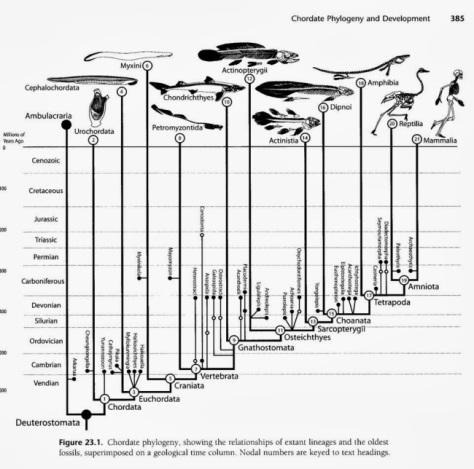
Craniata, with Cephalochordata (which includes Amphioxus) and Tunicata or Urochordata (which includes ascidians, salps, pyrosomes and larvaceans), constitute the Chordata.
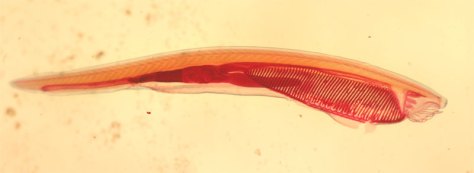
THE ORIGIN OF CHORDATA
Before focusing on the origin of the Craniata, let me mention the most accepted theory to explain the origin of chordates, which resulted in Craniata and vertebrates.
This is the Garstang’s theory. It proposes that the origin of chordates, which took place about 570 million years ago during the Precambrian, must be from some deuterostomes (animals in which the mouth is not formed from the blastopore of the early stages of development and that includes echinoderms, hemichordates and chordates). The larvae of these animals have some similarities with a chordate body plan: bilateral symmetry, unidirectional digestive tract and an adoral and circumoral ciliated band. Thus, it is believed that a deuterostom larva, perhaps the auricularia larvae of echinoderms, would have resulted in the evolutionary line of chordates.
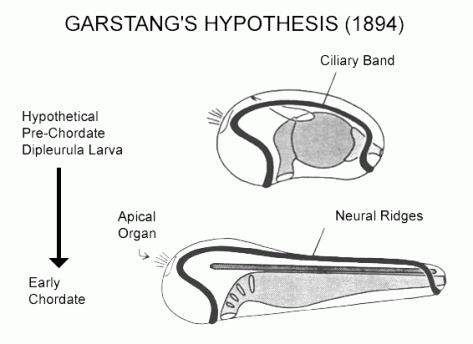
Chordates are a phylum of animals, with 55,000 different species. Although all members included in the group of chordates have very different aspects, they can be grouped by the fact that at some point in their development have 5 unique characteristics (synapomorphies):
- Notochord: it is a longitudinal rod positioned in the back of the body, which has the function of preventing the shortening of the body.
- Epineuria: the condition of the central nervous system present in the dorsal part of the body, above the notochord.
- Pharyngeal gill slits: they are openings communicating outside with the pharyngeal cavity.
- Endostyle: is a ventral groove with glandular walls located in the pharynx, the function of which is to secrete mucus to catch food, captures iodine and produce thyroid hormones.
- Caudal fin: a tail that extends beyond the anus.
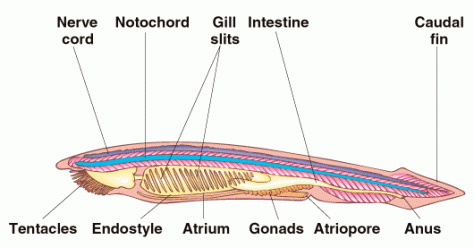
WHEN AND HOW DID THE VERTEBRATES APPEAR?
The increasing complexity of chordates gave rise to Craniata, which originated 544 million years ago in the Cambrian seawater.
Simplifying, one group of Prochordates (Urochordates and Cephalochordata) resulted in a procraniata. This was a benthic marine animal (fixed to the bottom) that fed by filtering suspended particles from the water. Thus, the increased mobility of the animal produced skeletal and muscle modifications, which would lead to Craniata. Here, there are some adaptations that led the evolution of Craniata:
- Changes in the muscles and skeleton: the rise in the skeleton would have allowed the increase of the segmented musculature (myomeres), which amended the form: V-shaped (amphioxus) to W-shaped, allowing better control movement. In addition, replacement of notochord by vertebral column explains the origin of vertebrates.
- Physiology: internal systems were modified to meet higher metabolic needs. Therefore, there was the gradual disappearance of cilia of the pharynx for food (ciliary pump) and appeared muscles (muscle pump). With the emergence of the gills, pharynx had a respiratory function. Muscles and digestive glands in the digestive tract also appeared. In addition, the heart and kidneys were originated.
- Nervous System: to locate and capture prey, chordates developed a more complex nervous system. In the frontal part of the neural tube, the brain was originated and was protected by the skull. Furthermore, it appeared a set of sense organs for receiving light, sound, taste, odors, electric current …
ROUGH OUTLINES IN THE DIVERSIFICATION OF CRANIATA
The origin of the Craniata occurred during the Cambrian with the appearance of agnates, that is, animals that had the characteristics of Craniata but had no jaws or any other grasping device. Currently, this group only includes lampreys and hagfish.
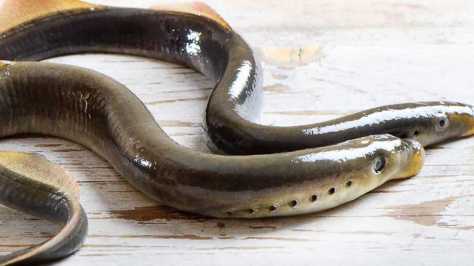
The next step was the emergence of the jaws during the Silurian. All jawed animals are included in the group gnathostomes. They include jawed fishes and tetrapods.
THE FIRST CRANIATA: THE OSTRACODERMS
The first vertebrates were a group of agnates called ostracoderms. They had many characteristics of Craniata. They were filter feeders with a powerful pharyngeal pump water into their mouth. The first ostracoderms had the body covered with bony plates. Thus, it is in this group where the bone first appears.
The ostracoderms include two main groups: Pteraspidomorphii and Cephalaspidomorphii
Pteraspidomorphii measured between 20 cm and 2 meters, with a small mouth surrounded by small plates, with well-developed eyes and unpaired fins. An example is Astraspis, which was between 12 and 35 cm long, it had an armor of bone plates between 3-5 mm, its eyes were protected by plates, it had pharyngeal slits and had sensory channels in the plates.
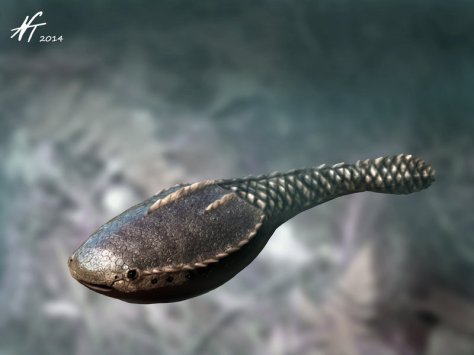
Cephalaspidomorphi were freshwater animals with a pair of pectoral fins, allowing them to control their body: tilt, deflection and rotation. An example is Cephalaspis, a small animal less than 30 cm long and covered with a heavy cuirass and a cephalic one-piece shield.
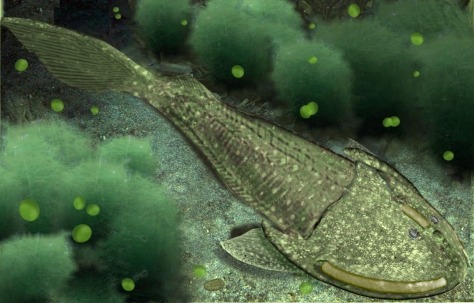
REFERENCES
- Apuntes de Cordados de la Licenciatura en Biología (UB).
- Hickman, Roberts, Larson, l’Anson & Eisenhour (2006). Principios integrales de Zoología. Ed. McGraw-Hill (13 ed.)
- Liem, Bemis, Walker & Grande (2001). Functional Anatomy of the Vertebrates. An Evolutionary Perspective. Brooks Cole Pub (3 ed)



5 pensaments sobre “The origin of vertebrates”